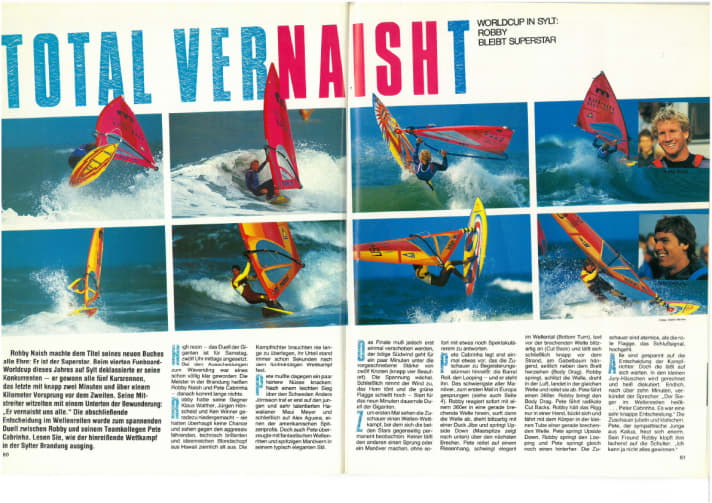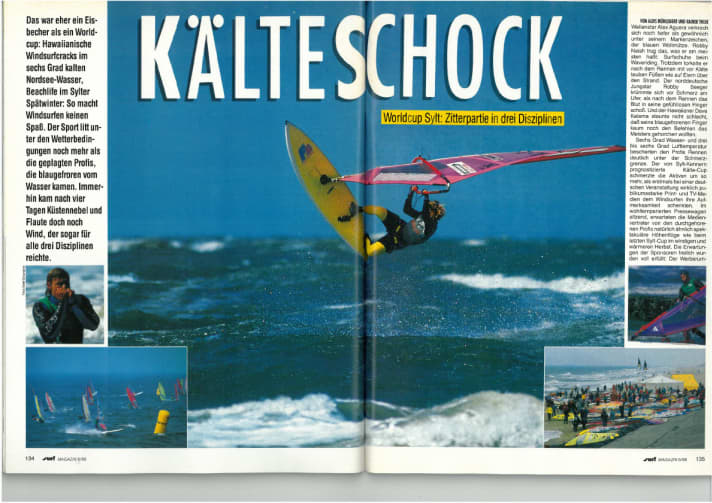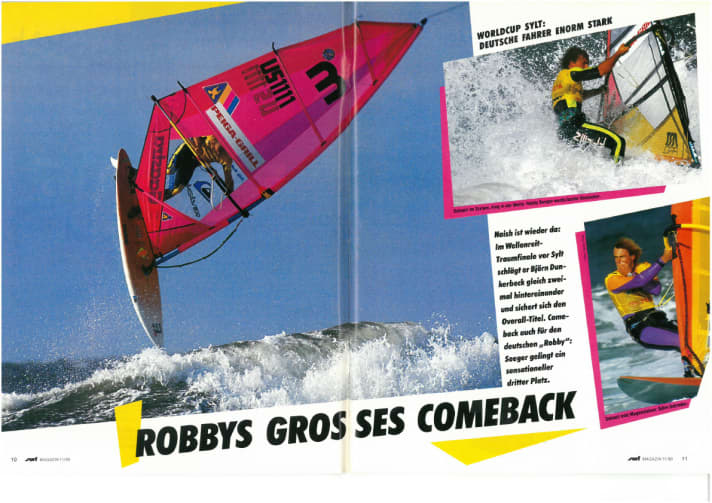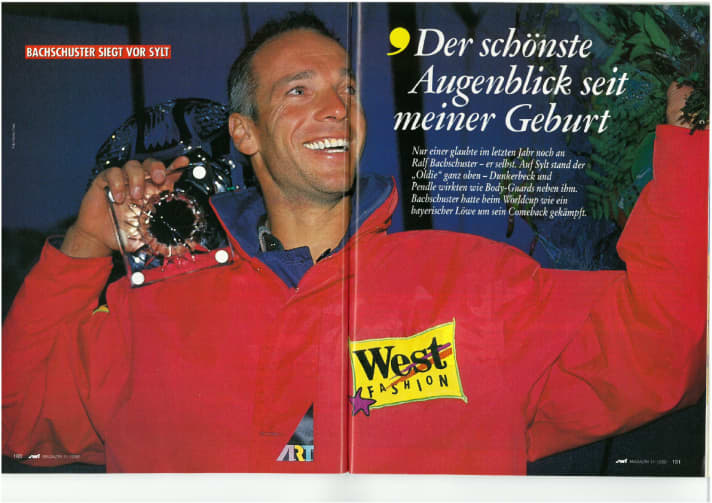History: The surf highlights from the World Cup Sylt - 1983 to 1992
Tobias Frauen
· 22.09.2025







Further reviews:
1983: Foam bath
The very first World Cup on Sylt was actually a Euro Funboard Cup. However, it was already clear that it would become something more, the sponsoring brewery had already promised a significant increase in prize money, and even the sceptical Sylt resort administration was convinced after the premiere. The event was also the first waveriding event in a European area, with the young Frenchman Eric Thieme winning in the wave. Germany's top star Jürgen Hönscheid only came fifth, but took the overall victory. A particular challenge was the up to two metre high foam carpet that lay in the surf zone due to the algae bloom. To entertain the spectators, the riders had to repeatedly search for their equipment in the foam.
1984: Total VerNaisht
Robby Naish is the undisputed superstar (also the name of a Delius Klasing book published at the same time) at the 1984 Sylt World Cup. He wins all five course races and delivers a highly exciting duel with Pete Cabrinha in the wave riding. Cabrinha made history in the process: In the final, he jumps a barrel roll, a precursor to the backloop, for the first time in Europe. After a lengthy jury deliberation, it was clear that he had won the wave competition!
But history is also being written in the course race: Robby's sailing sponsor Gaastra sends its riders to the start line with a new invention. Small braces on the batten press on the mast and ensure a stable sail profile - the camber is invented. And Robby also invents the "close the gap" on the water. He beat everyone else to it and won by a kilometre in some cases. Even the expensive profile masts don't stand a chance against this comparatively inexpensive tuning measure.
Meanwhile, there was criticism - even from Spiegel and ARD - of the poor organisation. A haphazard regatta management, a lack of press work and a completely undersized public address system caused displeasure.

1985: Long Saturday
With hardly any wind on Sylt, most of the pros are much busier at the bar of the "American" than on the beach. But somewhat surprisingly, 20 knots suddenly come out of nowhere on the second Saturday and some of the pros go straight from the party onto the water. Jürgen Hönscheid, actually the favourite, surprisingly loses to a young New Caledonian named Robert Teriitehau. To everyone's surprise, Robby Naish then wins the final against Pete Cabrinha - on slalom boards with six sails. "Obviously points are already being awarded here for swimming and pumping," grumbles Cabrinha to the judges.
In the course race, which starts on the same day, two surprise drivers come into focus: Axel Ohm is in the leading group for a long time and raises hopes of a German victory, and the Swede Anders Bringdal comes third in his very first World Cup. In addition, the regatta management and organisation are once again criticised this year (wrong flags, unsuccessful timekeeping and no supporting programme for calm conditions).
1986: Upward trend
The World Cup is gathering pace, more and more spectators want to be up close and personal on Brandenburg beach and a lot of press are on site. But at first they see nothing, the first course races take place in thick fog far off the coast. The focus is on Björn Schrader in particular, who is involved in close duels with Robby Naish and newcomer Anders Bringdal. At the same time, the 1986 World Cup also means a development boost: F2 shaper Peter Thommen has brought along new, triple concave boards, the sails come with cut-away.
After a few days in the doldrums, things continue, and on the second weekend, waveriding can also be started in 12 to 14 knots. But Jürgen Hönscheid grumbles: "You can't surf properly in these conditions. It's far too cold - all the World Cups have temperatures that can ruin your health!" And the Sylt groynes also ruin a few things, with lots of boards falling victim to the sharp piles of stones in the draining water until the brand representatives protest and the race organisers move the course. A certain Björn Dunkerbeck makes his first appearance in a wave final, but has no chance against Robby Naish.

1987: Naishville
In 1987, Robby is still the king of Sylt, winning the wave final on the first weekend - almost to the exclusion of the public, because a complaint from local residents meant that the races could no longer be presented between 1pm and 3pm. Most of the spectators had gone home because they thought the races were over. Dunkerbeck and Teriitehau were eliminated in the semi-final because they had to take a long walk on the beach after a wash. While Naish tried a double loop according to the report at the time, the single rotation is now also on the rise among the women. However, reigning world champion Natalie Siebel had to settle for third place in front of her home crowd.
Just in time for the second weekend, Robby Naish is featured in a 45-minute portrait on ZDF, which achieves record ratings. In it, he is described as a perfectionist, but the following day he falls far behind due to an incorrectly fastened mast sheet, of all things. This benefited the young Frenchman Patrice Belbeoc'h, from whom Naish only just managed to snatch overall victory. A new talent also emerges in the women's event: Jutta Müller wins two course races and finishes second overall.
1988: Cold shock
April instead of autumn: exceptionally much earlier than usual on the schedule, the 1988 World Cup turned into a nail-biter: with water temperatures of six degrees and air temperatures of three to six degrees, rows of Hawaiian fingers, spoilt by warmth, froze, even Robby Naish wore his unloved surf shoes. "After just a few minutes on the water, you lose the feeling for the board and rig," said Naish, describing the reason why he was riding "like a dork". The reason for the postponement was the organisers' fear that the Olympic Games could lure sponsors away. However, there were hardly any sporting highlights; as soon as a result was achieved in all disciplines and the press had their pictures, the regatta organisers decided it was too cold for surfing - even demo sessions were not allowed.
The overall winner was Anders Bringdal, who won the course race. In the slalom, on the other hand, Björn Dunkerbeck was impossible to beat. Robby Naish was only able to make it to the front in the wave riding - two clean loops and a few wave rides were enough for him, as most of the others could barely get their fins out of the water due to the cold. Jutta Müller won the women's course race, Britt Dunkerbeck the wave race.

1989: The new Naish
Others win, he is still the superstar: Robby Naish is surrounded by old and young fans on Sylt more than ever, even having to sign his autographs on Dunkerbeck photos (!). "The great pressure of having to win is gone," surf author Rainer Thide analyses Naish's new calmness. Dunkerbeck is completely different: "Second place is worth nothing. Only the win counts!". The two face each other in the wave final and delight the spectators with a synchronised forward loop.
In the course race, the riders are faced with the question: long raceboard or short slalom board? While Bernd Flessner takes to the water with slalom racers from the series, Björn Schrader and Axel Ohm opt for raceboards and finish just ahead of Flessner. The women struggled with the crisp conditions and many fell victim to the shore break. While Natalie Siebel wins the wave riding, Britt Dunkerbeck is right at the front in the slalom and course races.
1990: Robby's big comeback
Naish comes to Sylt in 1990 with a new girlfriend and new motivation. Once again, it's a duel between the giants and Björn Dunkerbeck in the wave final, but this time Robby wins. Björn, on the other hand, wrecks his equipment in the shorebreak and can't get back into the rhythm after a strong start. Robby Seeger moves up to third place, while Jutta Müller wins one of the women's finals against Britt Dunkerbeck. After a serious head injury, Natalie Siebel is travelling with a helmet and short hair and is able to win the second run. In the slalom, the young German skiers Bernd Flessner, Andy Laufer and Philipp Richter show their potential, but even Dunkerbeck has no chance against the outstanding Anders Bringdal.
In terms of setup, the World Cup on Sylt now sets standards: "If all World Cups were organised as professionally as the one on Sylt, windsurfing would have been a world sport for a long time!" enthuses PBA President Christian Herles. With a good TV presence (Jutta Müller in the sports studio), surf radio on the beach (with "young reporter" Ingo Meyer), skate shows and lots of media hype surrounding Team Germany, the event is getting bigger and bigger.

1991: Sylt freestyle concert
Things went even further up a year later: a tent village costing 600,000 marks, 40 hours of TV coverage, live broadcasts on NDR and much more attracted a great deal of attention. However, the tents had to be evacuated several times for safety reasons, and on Wednesdays there was a storm with eleven gale-force onshore winds, which meant that no official competitions were possible.
The spectators' favourite was once again Robby Naish, who won the eternal final with perfect tactics against a once again washed Dunkerbeck. But someone else also caused frenetic cheering on the beach: Bernd Flessner almost kicked Björn Dunkerbeck out in the semi-final with gigantic jumps: "On the apex [...] I suddenly heard the crowd screaming. It intoxicates you like a drug," Flessi revealed afterwards. Things went even better in the slalom, where he skied up to third place - fourth place overall. "I now know that I can beat everyone!" Nathalie Siebel won the women's wave and slalom, while Jutta Müller was shaken by the media hype.
1992: "The most beautiful moment since my birth"
The year 1992 stands out from the 40 years of World Cup history: Ralf Bachschuster was the first German to win the home event. It was also the only time the event was not held on Brandenburg beach. Stubborn weather conditions made for a capricious 10 to 18 knots of easterly wind. Apart from a few training strokes on the horizon, nothing can be done on the water. The World Cup therefore moves overnight to List in the Königshafen harbour. Ralf Bachschuster wins the only slalom there with outstanding speed and good tactics. Like many others, top favourite Dunkerbeck struggles with the short choppy waves in the waist-deep Königshafen (Björn Schrader: "You keep hitting a kerb."), Bachschuster seizes his chance and takes the much-celebrated victory!
In Westerland, on the other hand, the World Cup has once again gone one better, with an impressive set-up including a skate ramp, TV cutting room, helicopter and plenty of sponsor tents attracting tens of thousands of spectators. The relocation to List just about averts the sporting failure, but the discussion about the wind limit is heated throughout the week!

You can click through all the Sylt stories from 1983 to 1992 in the gallery above!
Further reviews:

